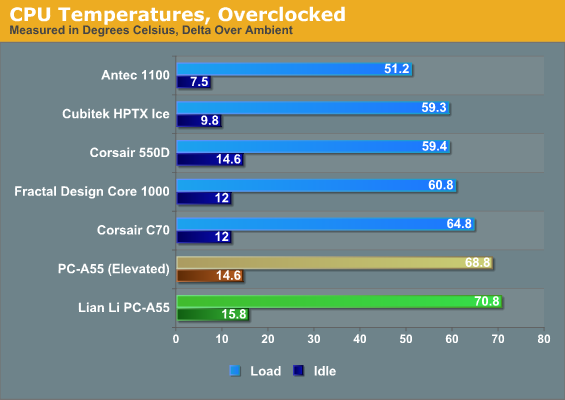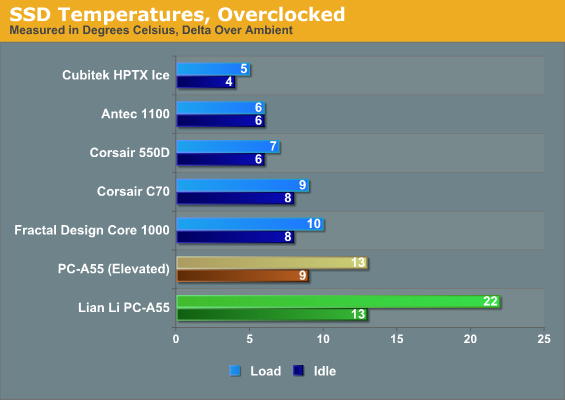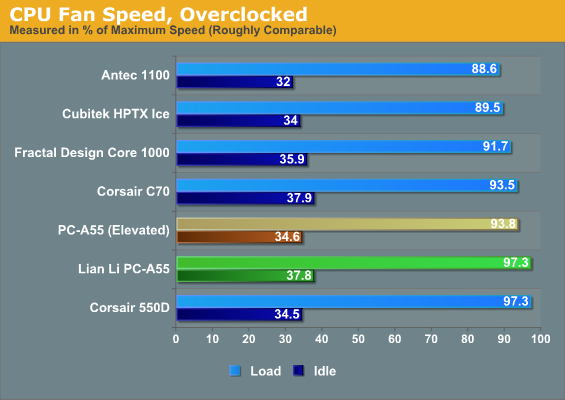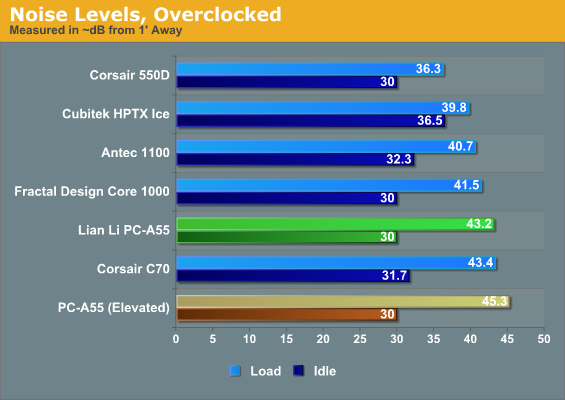Lian Li PC-A55 Case Review: Unfortunate Name Befits the Design
by Dustin Sklavos on June 16, 2012 12:30 PM EST- Posted in
- Cases/Cooling/PSUs
- mid-tower
- Lian Li
- ATX
Noise and Thermal Testing, Overclocked
Lian Li's PC-A55 is the first time I've actually been nervous about thermally testing a case. The CPU cores were already pushing the mid-to-high 80s at stock settings under load; how was this whole thing going to fare when I bumped up the clocks and pumped more voltage through the CPU and graphics card? As it turns out, it wasn't going to fare well at all, and I'm thankful we live in an era where our hardware has thermal protections in place. Ten years ago, I likely would've had to replace most of the testbed after this.



On the charts it doesn't look as bad, but keep in mind that the Intel Core i7-2700K's cores were actually hitting 95C with the case elevated, and 98C without. The GeForce GTX 560 Ti was also peaking at 95C. All of this in a room with an ambient temperature of about 24C, a temperature which isn't terribly uncomfortable or unreasonable. If the PC-A55 had a hard time dealing with a stock system, it flat out couldn't deal with any kind of overclocking. What's worse, look at how heat builds up around the SSD and imagine what would happen if a mechanical drive were used.


Our Cooler Master Hyper 212 Evo was being pushed as hard as it possibly could and the CPU thermals were still hitting the maximum spec. The normally efficient custom cooler on the ASUS GeForce GTX 560 Ti had just as hard a time, with the fan basically maxing out under load. Lian Li's design has virtually no thermal headroom. With the elevated testbed, the GPU does better, but even so it places last out of our set of cases.

The PC-A55 basically winds up being our worst-case scenario on almost all fronts. While it remains quiet at idle, under load it's very noisy and uncomfortable to listen to, due to the fact that the fans running inside are all going at full bore. As a side note, because of the aluminum shell, the top of the case was actually almost painfully hot to the touch when tested under these conditions. Putting the case on a flat surface helped thermals a bit, but also gave noise one more place to escape, causing it to run even louder.










64 Comments
View All Comments
Iketh - Saturday, June 16, 2012 - link
I already have 3 HDDs installed, why do I need the cage?Iketh - Saturday, June 16, 2012 - link
BTW, that's a passively cooled 2600k @ 4.3GHz at 79C with prime load WITH THE DOORS OFFhowever, evo + 2600k is lapped
Olaf van der Spek - Saturday, June 16, 2012 - link
Passive? As in no fans at all?Without the cage the case looks good.
wifiwolf - Sunday, June 17, 2012 - link
Doesn't seem right to passively cool the cpu and have fan in the front and back.The noise will still be there, having a low noise cpu fan there wouldn't add any noticeable noise
Iketh - Sunday, June 17, 2012 - link
then i guess when i tested the noise levels with and without and found a very noticeable improvement, i must be absolutely incompetent to make the judgement... thank you for showing me the path wifiwolfdoctormonroe - Saturday, June 16, 2012 - link
PC-X500/PC-X500FX in the mATX formfactor would be brilliant, hopefully it would be cheaper as well...etamin - Saturday, June 16, 2012 - link
I've been wondering why Lian Li (or any other company) hasn't employed the 90 degree rotated design that Silverstone uses. Is it under patent protection?InterClaw - Saturday, June 16, 2012 - link
It seems like a major mistake to not let the PSU get its own air from the front, especially since it dumps its hot air at the bottom of the case. The way it is now it just recycles its own hot air. Genius... This is beside all the other cooling problems what with the GFX blocking the flow.Dustin, I'm curious though why you mounted the CPU cooler horizontally and not vertically to help the airflow along. Was it not possible or is that deviating from the testing methodology since the heat sink might perform differently after being reseated?
RanDum72 - Saturday, June 16, 2012 - link
I cannot believe that the case designers never thought about where the PSU exhaust is going to come out. The heat generated by the PSU is dumped inside the case. They could have drilled some holes that aligns with the PSU exhaust but even that will also be picked up by the bottom fan and thrown back into the case. All form, no function.kesbar - Saturday, June 16, 2012 - link
after looking at the thermal results, the PC-A55 has carpet burn.